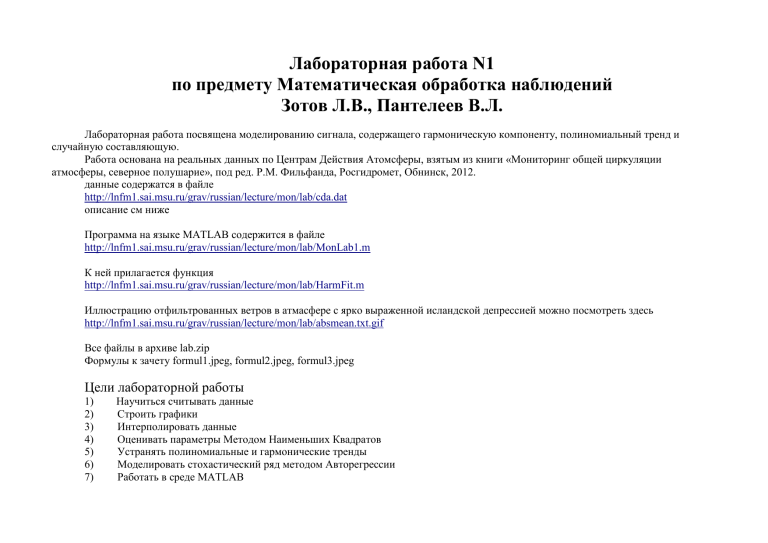
Лабораторная работа N1
по предмету Математическая обработка наблюдений
Зотов Л.В., Пантелеев В.Л.
Лабораторная работа посвящена моделированию сигнала, содержащего гармоническую компоненту, полиномиальный тренд и
случайную составляющую.
Работа основана на реальных данных по Центрам Действия Атомсферы, взятым из книги «Мониторинг общей циркуляции
атмосферы, cеверное полушарие», под ред. Р.М. Фильфанда, Росгидромет, Обнинск, 2012.
данные содержатся в файле
http://lnfm1.sai.msu.ru/grav/russian/lecture/mon/lab/cda.dat
описание см ниже
Программа на языке МАTLAB содержится в файле
http://lnfm1.sai.msu.ru/grav/russian/lecture/mon/lab/MonLab1.m
К ней прилагается функция
http://lnfm1.sai.msu.ru/grav/russian/lecture/mon/lab/HarmFit.m
Иллюстрацию отфильтрованных ветров в атмасфере с ярко выраженной исландской депрессией можно посмотреть здесь
http://lnfm1.sai.msu.ru/grav/russian/lecture/mon/lab/absmean.txt.gif
Все файлы в архиве lab.zip
Формулы к зачету formul1.jpeg, formul2.jpeg, formul3.jpeg
Цели лабораторной работы
1)
2)
3)
4)
5)
6)
7)
Научиться считывать данные
Строить графики
Интерполировать данные
Оценивать параметры Методом Наименьших Квадратов
Устранять полиномиальные и гармонические тренды
Моделировать стохастический ряд методом Авторегрессии
Работать в среде MATLAB
После ознакомления с программой необходимо самостоятельно
1)
2)
3)
4)
5)
6)
7)
При использовании данных ЦАМ заменить Исландский минимум на Сибирский максимум.
Сгенерировать собственный сигнал из гармонической, полиномиальной, случайной компонент. Применить анализ к нему.
Исключить из ряда больше точек. Принтерполировать, изменив метод интерполирования.
Вычислить коэффициенты кросс-корреляции для компонент давления и широты/долготы.
Подобрать несколько гармоник различных/других периодов.
Изменить порядок полинома тренда.
Изменить порядок авторегрессии.
ЦЕНТРЫ ДЕЙСТВИЯ АТМОСФЕРЫ
Под центрами действия атмосферы (ЦДА) понимают области низкого и высокого приземного давления, обнаруживаемые на
многолетних средних картах месяца или сезона.
Центры действия атмосферы, являясь крупными объектами общей циркуляции атмосферы, характеризуют основные системы
барических образований и в своей динамике отражают многие особенности климата и погоды, вследствие чего эти центры, не без
основания, иногда называют "климатическими центрами действия". Центры тесным образом сопряжены с другими объектами общей
циркуляции атмосферы (пассатами, муссонами, зонами активного тропического циклогенеза и т.д.). Кроме того, существует
определенная связь между поведением центров действия атмосферы и термодинамическим состоянием океанов, а также с некоторыми
внешними факторами (солнечной активностью и геодинамикой).
Центры действия атмосферы подразделяются на перманентные (формирующиеся в любое время года) и сезонные (т.е. такие,
которые в данном регионе формируются не во всех сезонах года). К первым, формирующимся в течение всего года, относятся
океанические центры: над Атлантическим океаном - Азорский максимум и Исландский минимум, над Тихим океаном Гонолульский максимум и Алеутский минимум. К сезонным ЦДА относятся Сибирский и Канадский максимумы, которые
формируются над континентом в холодное полугодие, а также Азиатский и Калифорнийский минимумы, которые формируются над
континентами в теплое полугодие. В силу глобальных аномалий общей циркуляции атмосферы в том или ином месяце как
перманентные, так и сезонные ЦДА в некоторых регионах могут отсутствовать, а сезонные запаздывать либо опережать обычное время
формирования.
Исходным материалом при подготовке данных по ЦДА послужили среднемесячные карты атмосферного давления на уровне моря над
Северным полушарием. Эти данные до 1967 г. были обобщены и опубликованы в работе А.И.Соркиной. (Многолетние колебания средних
месячных величин интенсивности и средних месячных географических положений центров действия атмосферы в северном
полушарии. Синоптический бюллетень. Северное полушарие. Приложение №2. Таблицы. – М., 1972. –35 с.)
С 1968 г. работа по сбору и подготовке данных по ЦДА была продолжена во ВНИИГМИ-МЦД до 2000 г., а в последующие годы – в
Гидрометцентре России. Данные по центрам действия атмосферы периодически публиковались в бюллетенях «Мониторинг общей
циркуляции атмосферы. Северное полушарие.» по 5-летним периодам (1985-1990, 1991-1995, 1996-2000 гг.).
Принцип снятия данных был аналогичным, как и при снятии данных опубликованных в работе А.И. Соркиной и бюллетенях
мониторинга. С карт снимались координаты центров барических образований и значения давления в этих центрах. В те месяцы, когда
формирование того или иного ЦДА не наблюдалось, соответствующие сведения в таблице отсутствуют. В некоторых случаях, снятие
данных по интенсивности и местоположению ЦДА произведено ориентировочно.
Сведения по ЦДА приведены за весь имеющийся ряд с 1891 по 2010 гг. в истинных значениях. По этим значениям можно
рассчитать климатические нормы за любые временные интервалы, их среднеквадратические отклонения, коэффициенты корреляции и
другие статистические характеристики.
Нами приведены нормы для двух временных периодов: 1891-1967 гг.1968-2010 гг., соответственно представленные в табл.1,2.
Архив данных по 5-и Центрам действия атмосферы приведен за период 1891–2010 гг.
Каждая запись архива содержит информацию за один месяц конкретного года, которая включает в
себя долготу (λ), широту (φ) и интенсивность (p) соответственно для Азорского, Исландского,
Гонолульского, Алеутского и Сибирского центров.
В случае отсутствия Центра его параметры принимают значения константы –32768.
ГОД
Месяц
Азорский максимум
λ
1891
...
1
φ
12
38
p
1020
Исландский минимум
λ
φ
25
60
Гонолульский
максимум
p
λ
φ
p
1003 -32768 -32768 -32768
Алеутский минимум
λ
154
φ
53
p
1001
Сибирский максимум
λ
-98
φ
46
p
1034
